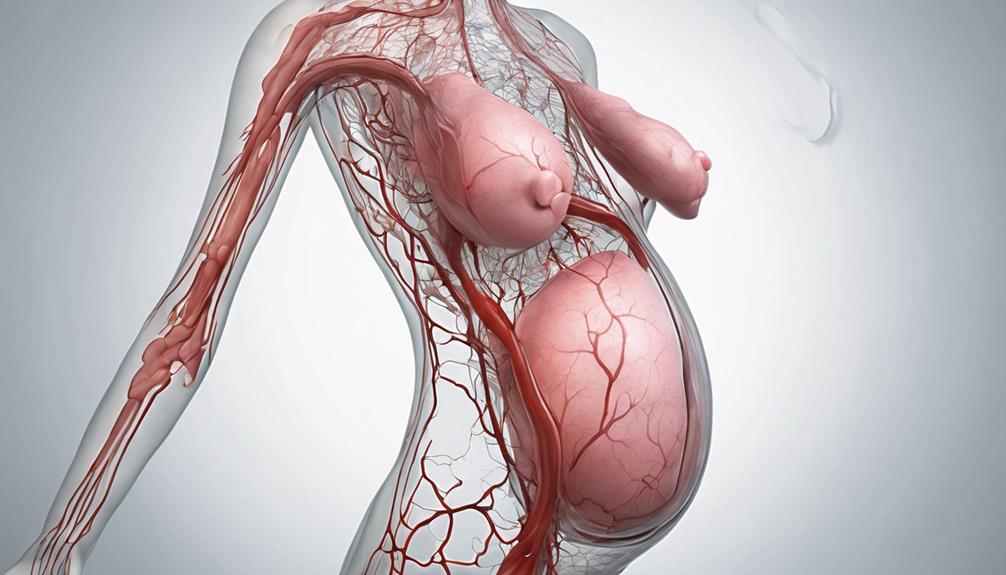Throughout pregnancy, the second trimester often brings about a perplexing yet gentle occurrence, like a calm stream – the presence of watery discharge.
While this occurrence is not uncommon, the underlying reasons can be multifaceted and intriguing. Understanding the nuances behind this watery discharge can shed light on the intricate workings of the body during this pivotal phase of pregnancy.
Let's uncover the veiled causes that may be contributing to this delicate flow and unravel the mysteries that lie within this natural process.
Key Takeaways
- Hormonal changes and increased secretions lead to watery discharge during the second trimester.
- Infections and vaginal irritations can also cause excessive watery discharge.
- Potential amniotic fluid leaks should be promptly evaluated by a healthcare provider.
- Cervical changes and mucus plug loss contribute to increased watery discharge in the second trimester.
Hormonal Changes and Increased Secretions
Hormonal fluctuations in the second trimester of pregnancy trigger an increase in vaginal secretions, leading to watery discharge as a normal protective mechanism for the birth canal. During this time, the body's increased estrogen levels play a vital role in stimulating the production of watery discharge. This physiological response helps safeguard the birth canal from infections and supports vaginal health throughout pregnancy. The watery discharge, akin to physiological leucorrhea, is a clear and thin fluid that's necessary for maintaining the delicate balance in the pelvic region.
These changes are perfectly normal and indicate that your body is adapting to the demands of pregnancy. Understanding that the increased secretions and watery discharge are nature's way of protecting both you and your baby. Embracing these changes as part of the miraculous journey of pregnancy can bring comfort and reassurance during this transformative time. Remember, your body is equipped to handle these adjustments, ensuring the well-being of you and your growing little one.
Infections and Vaginal Irritations

Experiencing watery discharge in the second trimester of pregnancy can sometimes be attributed to infections or vaginal irritations rather than solely hormonal changes. Infections like bacterial vaginosis or yeast infections, as well as vaginal irritations from soaps, douches, or synthetic underwear, can lead to increased watery discharge during this stage of pregnancy. Hormonal changes in pregnancy can make the vagina more prone to infections, resulting in watery discharge. It is vital to seek prenatal care if you suspect an infection or irritation, as healthcare providers can diagnose and treat the underlying cause effectively to guarantee a healthy pregnancy. Additionally, practicing good hygiene, such as avoiding harsh soaps and opting for cotton underwear, can help prevent infections and reduce watery discharge. Below is a table summarizing key points related to infections and vaginal irritations during the second trimester:
| Infections and Vaginal Irritations | Effects |
|---|---|
| Bacterial Vaginosis | Increased watery discharge |
| Yeast Infections | Excessive vaginal discharge |
| Vaginal Irritations | Discomfort and itching |
| Hygiene Practices | Prevention of infections |
Potential Amniotic Fluid Leaks
Watery discharge in the second trimester of pregnancy may sometimes be confused with potential amniotic fluid leaks, which can have significant implications for maternal and fetal health. When dealing with this issue, it's important to be aware of the following:
- Amniotic Fluid Characteristics: Amniotic fluid is clear and odorless, resembling water. It can leak in varying amounts, either gradually or in a sudden gush.
- Diagnostic Methods: Testing for amniotic fluid leakage involves checking the fluid's pH level or conducting a sterile speculum exam to confirm the presence of amniotic fluid.
- Urgency of Evaluation: A rupture of membranes leading to a continuous trickle of amniotic fluid necessitates immediate medical attention. Prompt intervention is of utmost importance to confirm amniotic fluid leakage and prevent potential complications during pregnancy.
If you suspect amniotic fluid leakage, seek medical advice promptly to guarantee the well-being of both you and your baby.
To address any concerns or uncertainties regarding amniotic fluid leaks during pregnancy is crucial to safeguard maternal and fetal health.
Cervical Changes and Mucus Plug Loss
During the second trimester of pregnancy, changes in the cervix often lead to an increase in watery discharge as it softens and produces more mucus. Hormonal shifts during this period can stimulate the cervix to produce additional watery discharge, which is typically clear or white in color and odorless.
One significant event that can cause watery discharge is the loss of the mucus plug, a thick barrier of mucus that seals the cervix during pregnancy. Monitoring these changes in watery discharge can provide insights into cervical health and potential labor preparation.
It's crucial to stay vigilant and consult with healthcare providers if there are concerns about the amount, color, or odor of the discharge. Understanding these cervical changes and the loss of the mucus plug can help expecting parents feel more prepared for the later stages of pregnancy.
Preterm Labor Concerns
As the second trimester progresses, staying vigilant for any signs of preterm labor, including changes in discharge, is essential for ensuring the health and well-being of both the mother and the baby.
Here are three key points to keep in mind:
- Prompt Medical Evaluation: Any indication of watery discharge during the second trimester should be promptly assessed by a healthcare provider to determine the possibility of preterm labor.
- Health Risks of Preterm Labor: Preterm labor can lead to early delivery, presenting potential health risks for both the mother and the baby. Monitoring for signs of preterm labor, such as watery discharge, is important to mitigate these risks.
- Early Detection and Intervention: Early detection of preterm labor through monitoring changes in discharge can allow for timely intervention, which may help prevent complications and improve outcomes for both the mother and the baby. Remember, your healthcare provider is there to support you through this journey.
Frequently Asked Questions
Is It Normal to Have Watery Discharge in the Second Trimester of Pregnancy?
Yes, it's normal to experience watery discharge during the second trimester of pregnancy. This discharge, known as leukorrhea, helps maintain vaginal health. It's typically thin, milky-white, and increases as pregnancy progresses. Monitoring it is essential for overall well-being.
Is It Normal to Leak Fluid in Second Trimester?
Ensuring to differentiate between normal watery discharge and potential amniotic fluid leakage in the second trimester is crucial. Consulting a healthcare provider for evaluation is advisable. Monitoring changes in discharge helps guarantee the well-being of both mother and baby.
Is It Normal to Leak Clear Watery Fluid During Pregnancy?
It's important to differentiate between normal discharge and amniotic fluid leakage during pregnancy. Clear watery fluid can be a sign of amniotic fluid leakage, requiring immediate medical attention to guarantee the safety of both mother and baby.
When Should I Be Concerned About Discharge in Second Trimester?
When noticing changes in discharge during the second trimester, any abnormal colors, odors, or discomfort should prompt seeking medical advice. Monitoring and discussing concerns promptly with a healthcare provider guarantees the well-being of both mother and baby.
Conclusion
To summarize, watery discharge during the second trimester of pregnancy is often a normal occurrence due to hormonal changes and increased secretions.
It's important to monitor any changes in discharge and consult a healthcare provider if there are concerns about amniotic fluid leakage.
Remember, when it comes to watery discharge, it's better to be safe than sorry. After all, a stitch in time saves nine.









